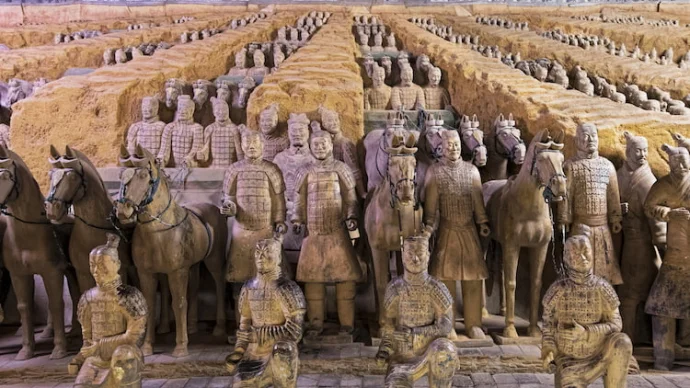
About Terracotta Warriors
The Terracotta Warriors part of the Mausoleum of the First Qin Emperor in modern day Xi’an, China, is one of the world’s most famous, intriguing and visually arresting ancient sites, dating back to the third century BC.
History of the Terracotta Warriors
A chance find by a group of farmers in Xian in 1974, the Terracotta Warriors is a collection of around 7,000 life sized clay sculptures of soldiers, infantry, carts and horses in battle formation, each created with its own individual features in extraordinary detail. Prior to this, the area had been noted for the fact that pieces of terracotta were frequently found.
The Terracotta Army was created during the reign of Ying Zheng (246-210 BC) who, after several military victories became known as the First Emperor of Qin, Shi Huang Di. The Terracotta Army formed part of the elaborate mausoleum of Qin Shi Huang, built from 221 BC to his death in 210 BC. It’s thought that Qin Shi Huand either feared retribution in death for those he’d vanquished in life, or that he believed his rule would continue on into the afterlife.
The location was significant and thought to be auspicious as both jade and gold were found in abundance at the nearby Mount Li.
Today, the Terracotta Army is a UNESCO World Heritage site.
The Terracotta Warriors today
Unsurprisingly, this is one of the most astounding archaeological sites in the world, and it’s rightfully busy, especially at peak seasons like the summer and often around Chinese New Year. It’s best to visit the site in reverse, building up to the big finale. There are 3 main pits to visit, each holding more and more warriors.
Also be sure to visit the large modern museum, the Qin Shi Huang Emperor Tomb Artefact Exhibition Hall and the bronze chariots and horses that were unearthed just west of the main pits, Expect your visit to take several hours, if not a full half day as there’s a lot to explore and take in.
Getting to the Terracotta Warriors
The warriors are just outside of the city of Xi’an – hop on bus 914 or 915 from Xi’an train station (they depart very regularly) and stay on until the last stop. The same buses do the return journey from the parking lot outside.
You can also drive: it’s about an hour from Xi’an, between Xi’an and Weinan – the car park is a 15 minute walk from the site itself, There are plenty of amenities in the vicinity if you want to stock up on (slightly tacky) souvenirs or grab a bite to eat.
Featured In

China Historic Sites
Discover China's rich history at these 10 sites across the country, from the ancient Terracotta Army to the birthplace of Mao Zedong.




















